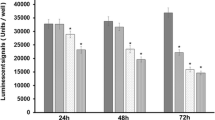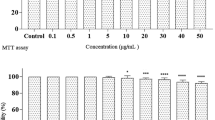Abstract
The shrimp farming has been converted into a mature aquaculture industry dealing with over millions of metric tonnes of processed commodities. Nevertheless, the global shrimp productions are constantly threatened by disease outbreaks, mainly triggered by rapidly disseminating viruses. Infectious myonecrosis virus (IMNV) is one of these epizootic agents affecting shrimp production in Brazil, of which no treatment exists. Herein, the antiviral activity against IMNV of an eicosapeptide, named Ctn[15-34], derived from a member of the cathelicidin family of antimicrobial peptides, was demonstrated. Cultures of hemocytes from Litopenaeus vannamei were established that support IMNV replication and infectivity titration. The cytotoxic effect of IMNV in culture and the in vitro anti-IMNV activity of Ctn[15-34] were assessed using a high-sensitive fluorescent-based method in combination with quantitative PCR. The Ctn[15-34] (<12.5 µM) neutralized the toxic effects of IMNV at loads sufficient to kill 50% of shrimp hemocytes. This study reported for the first time the replication of IMNV in vitro and the employment of a straightforward methodology to assess cell viability and viral/antiviral activities. In addition, it provided the basis for the development of the anti-infective multi-effector Ctn[15-34] eicosapeptide and analogs as components of antiviral formulations against shrimp viral diseases.







Similar content being viewed by others
References
Busayarat, N., Senapin, S., Tonganunt, M., Phiwsaiya, K., Meemetta, W., Unajak, S., et al. (2011). Shrimp laminin receptor binds with capsid proteins of two additional shrimp RNA viruses YHV and IMNV. Fish & Shellfish Immunology, 31, 66–72. doi:10.1016/j.fsi.2011.03.007.
Cavalcante, C. S. P., Falcão, C. B., Fontenelle, R. O. S., Andreu, D., & Rádis-Baptista, G. (2016). Antifungal activity of Ctn[15-34], the C-terminal peptide fragment of crotalicidin, a rattlesnake venom gland cathelicidin. Journal of Antibiotics (Tokyo). doi:10.1038/ja.2016.135.
Chu, H. L., Yu, H. Y., Yip, B. S., Chih, Y. H., Liang, C. W., Cheng, H. T., et al. (2013). Boosting salt resistance of short antimicrobial peptides. Antimicrobial Agents and Chemotherapy, 57, 4050–4052. doi:10.1128/AAC.00252-13.
Dantas-Lima, J. J., Corteel, M., Oanh, D. T. H., Bossier, P., Sorgeloos, P., & Nauwynck, H. J. (2012). Development of two haemocyte culture systems (in attachment and in suspension) for shrimp immunity studies. Aquaculture, 366–367, 17–26. doi:10.1016/j.aquaculture.2012.08.032.
Deepika, A., Makesh, M., & Rajendran, K. V. (2014). Development of primary cell cultures from mud crab, Scylla serrata, and their potential as an in vitro model for the replication of white spot syndrome virus. In Vitro Cellular and Developmental Biology. Animal, 50, 406–416. doi:10.1007/s11626-013-9718-x.
Falcao, C. B., de La Torre, B. G., Perez-Peinado, C., Barron, A. E., Andreu, D., & Radis-Baptista, G. (2014). Vipericidins: A novel family of cathelicidin-related peptides from the venom gland of South American pit vipers. Amino Acids, 46, 2561–2571. doi:10.1007/s00726-014-1801-4.
Falcao, C. B., Perez-Peinado, C., de la Torre, B. G., Mayol, X., Zamora-Carreras, H., Jimenez, M. A., et al. (2015). Structural dissection of crotalicidin, a rattlesnake venom cathelicidin, retrieves a fragment with antimicrobial and antitumor activity. Journal of Medicinal Chemistry, 58, 8553–8563. doi:10.1021/acs.jmedchem.5b01142.
Feijo, R. G., Maggioni, R., Cunha Martins, P. C., de Abreu, K. L., Oliveira-Neto, J. M., Guertler, C., et al. (2015). RNAi-based inhibition of infectious myonecrosis virus replication in Pacific white shrimp Litopenaeus vannamei. Diseases of Aquatic Organisms, 114, 89–98. doi:10.3354/dao02853.
Flegel, T. W. (2012). Historic emergence, impact and current status of shrimp pathogens in Asia. Journal of Invertebrate Pathology, 110, 166–173. doi:10.1016/j.jip.2012.03.004.
Frantz, C., Stewart, K. M., & Weaver, V. M. (2010). The extracellular matrix at a glance. Journal of Cell Science, 123, 4195–4200. doi:10.1242/jcs.023820.
George, S. K., Kaizer, K. N., Betz, Y. M., & Dhar, A. K. (2011). Multiplication of Taura syndrome virus in primary hemocyte culture of shrimp (Penaeus vannamei). Journal of Virological Methods, 172, 54–59. doi:10.1016/j.jviromet.2010.12.020.
Jayesh, P., Philip, R., & Singh, I. S. (2015). Multifactorial interaction of growth factors on Penaeus monodon lymphoid cells and the impact of IGFs in DNA synthesis and metabolic activity in vitro. Cytotechnology, 67, 559–571. doi:10.1007/s10616-014-9697-0.
Jayesh, P., Seena, J., & Singh, I. S. (2012). Establishment of shrimp cell lines: perception and orientation. Indian Journal of Virology, 23, 244–251. doi:10.1007/s13337-012-0089-9.
Jenssen, H., Hamill, P., & Hancock, R. E. (2006). Peptide antimicrobial agents. Clinical Microbiology Reviews, 19, 491–511. doi:10.1128/CMR.00056-05.
Jiang, Y., Zhan, W., Wang, S., & Xing, J. (2006). Development of primary shrimp hemocyte cultures of Penaeus chinensis to study white spot syndrome virus (WSSV) infection. Aquaculture, 253, 114–119. doi:10.1016/j.aquaculture.2005.07.045.
Jose, S., Jayesh, P., Mohandas, A., Philip, R., & Bright Singh, I. S. (2011). Application of primary haemocyte culture of Penaeus monodon in the assessment of cytotoxicity and genotoxicity of heavy metals and pesticides. Marine Environment Research, 71, 169–177. doi:10.1016/j.marenvres.2010.12.008.
Jose, S., Jayesh, P., Sudheer, N. S., Poulose, G., Mohandas, A., Philip, R., et al. (2012). Lymphoid organ cell culture system from Penaeus monodon (Fabricius) as a platform for white spot syndrome virus and shrimp immune-related gene expression. Journal of Fish Diseases, 35, 321–334. doi:10.1111/j.1365-2761.2012.01348.x.
Jose, S., Mohandas, A., Philip, R., & Bright Singh, I. S. (2010). Primary hemocyte culture of Penaeus monodon as an in vitro model for white spot syndrome virus titration, viral and immune related gene expression and cytotoxicity assays. Journal of Invertebrate Pathology, 105, 312–321. doi:10.1016/j.jip.2010.08.006.
Kosciuczuk, E. M., Lisowski, P., Jarczak, J., Strzalkowska, N., Jozwik, A., Horbanczuk, J., et al. (2012). Cathelicidins: Family of antimicrobial peptides. A review. Molecular Biology Reports, 39, 10957–10970. doi:10.1007/s11033-012-1997-x.
Lakshmi, B., Viswanath, B., & Sai Gopal, D. V. (2013). Probiotics as antiviral agents in shrimp aquaculture. Journal of Pathogens, 2013, 424123. doi:10.1155/2013/424123.
Li, W., Desmarets, L. M., De Gryse, G. M., Theuns, S., Van Tuan, V., Van Thuong, K., et al. (2015a). Virus replication cycle of white spot syndrome virus in secondary cell cultures from the lymphoid organ of Litopenaeus vannamei. Journal of General Virology, 96, 2844–2854. doi:10.1099/vir.0.000217.
Li, S., Guo, S., Li, F., & Xiang, J. (2015b). Functional diversity of anti-lipopolysaccharide factor isoforms in shrimp and their characters related to antiviral activity. Marine Drugs, 13, 2602–2616. doi:10.3390/md13052602.
Li, Y., Xiang, Q., Zhang, Q., Huang, Y., & Su, Z. (2012). Overview on the recent study of antimicrobial peptides: Origins, functions, relative mechanisms and application. Peptides, 37, 207–215. doi:10.1016/j.peptides.2012.07.001.
Lightner, D. V. (2011). Virus diseases of farmed shrimp in the Western Hemisphere (the Americas): A review. Journal of Invertebrate Pathology, 106, 110–130. doi:10.1016/j.jip.2010.09.012.
Lightner, D. V., Redman, R. M., Pantoja, C. R., Tang, K. F., Noble, B. L., Schofield, P., et al. (2012). Historic emergence, impact and current status of shrimp pathogens in the Americas. Journal of Invertebrate Pathology, 110, 174–183. doi:10.1016/j.jip.2012.03.006.
Liu, Y. C., Li, F. H., Dong, B., Wang, B., Luan, W., Zhang, X. J., et al. (2007). Molecular cloning, characterization and expression analysis of a putative C-type lectin (Fclectin) gene in Chinese shrimp Fenneropenaeus chinensis. Molecular Immunology, 44, 598–607. doi:10.1016/j.molimm.2006.01.015.
Liu, W. J., Li, Y. C., Kou, G. H., & Lo, C. F. (2016). Laminin receptor in shrimp is a cellular attachment receptor for white spot syndrome virus. PLoS ONE, 11, e0156375. doi:10.1371/journal.pone.0156375.
Liu, H., Soderhall, K., & Jiravanichpaisal, P. (2009). Antiviral immunity in crustaceans. Fish & Shellfish Immunology, 27, 79–88. doi:10.1016/j.fsi.2009.02.009.
Maeda, M., Saitoh, H., Mizuki, E., Itami, T., & Ohba, M. (2004). Replication of white spot syndrome virus in ovarian primary cultures from the kuruma shrimp, Marsupenaeus japonicus. Journal of Virology Methods, 116, 89–94. doi:10.1016/j.jviromet.2003.10.013.
Maisetta, G., Di Luca, M., Esin, S., Florio, W., Brancatisano, F. L., Bottai, D., et al. (2008). Evaluation of the inhibitory effects of human serum components on bactericidal activity of human beta defensin 3. Peptides, 29, 1–6. doi:10.1016/j.peptides.2007.10.013.
Naim, S., Tang, K. F., Yang, M., Lightner, D. V., & Nibert, M. L. (2015). Extended genome sequences of penaeid shrimp infectious myonecrosis virus strains from Brazil and Indonesia. Archives of Virology, 160, 1579–1583. doi:10.1007/s00705-015-2406-2.
Nunes, A. J. P., Martins, P. C. C., & Gesteira, T. C. V. (2004). Carcinicultura ameacada: produtores sofrem com as mortalidades decorrentes do virus da mionecrose infecciosa (IMNV). Rev Panorama Aquicultura, 14, 37–51. (in Portuguese).
Poulos, B. T., Tang, K. F., Pantoja, C. R., Bonami, J. R., & Lightner, D. V. (2006). Purification and characterization of infectious myonecrosis virus of penaeid shrimp. Journal of General Virology, 87, 987–996. doi:10.1099/vir.0.81127-0.
Rampersad, S. N. (2012). Multiple applications of Alamar Blue as an indicator of metabolic function and cellular health in cell viability bioassays. Sensors (Basel), 12, 12347–12360. doi:10.3390/s120912347.
Shekhar, M. S., & Lu, Y. (2009). Application of nucleic-acid-based therapeutics for viral infections in shrimp aquaculture. Marine Biotechnology (NY), 11, 1–9. doi:10.1007/s10126-008-9155-0.
Skalickova, S., Heger, Z., Krejcova, L., Pekarik, V., Bastl, K., Janda, J., et al. (2015). Perspective of use of antiviral peptides against influenza virus. Viruses, 7, 5428–5442. doi:10.3390/v7102883.
Stentiford, G. D., Neil, D. M., Peeler, E. J., Shields, J. D., Small, H. J., Flegel, T. W., et al. (2012). Disease will limit future food supply from the global crustacean fishery and aquaculture sectors. Journal of Invertebrate Pathology, 110(2), 141–157. doi:10.1016/j.jip.2012.03.013.
Tang, K. F., Pantoja, C. R., Poulos, B. T., Redman, R. M., & Lightner, D. V. (2005). In situ hybridization demonstrates that Litopenaeus vannamei, L. stylirostris and Penaeus monodon are susceptible to experimental infection with infectious myonecrosis virus (IMNV). Diseases of Aquatic Organisms, 63, 261–265. doi:10.3354/dao063261.
Tonganunt, M., Nupan, B., Saengsakda, M., Suklour, S., Wanna, W., Senapin, S., et al. (2008). The role of Pm-fortilin in protecting shrimp from white spot syndrome virus (WSSV) infection. Fish & Shellfish Immunology, 25, 633–637. doi:10.1016/j.fsi.2008.08.006.
Vieira-Girão, P. R. N., Rocha, I. R. C. B., Costa, F. H. F., & Radis-Baptista, G. (2012). Differential induction of HSP-70 expression in response to IHHNV in white shrimp Litopenaeus vannamei naturally co-infected with IHHNV and IMNV. International Aquatic Research. doi:10.1186/2008-6970-4-17.
Wang, Y. T., Liu, W., Seah, J. N., Lam, C. S., Xiang, J. H., Korzh, V., et al. (2002). White spot syndrome virus (WSSV) infects specific hemocytes of the shrimp Penaeus merguiensis. Diseases of Aquatic Organisms, 52, 249–259. doi:10.3354/dao052249.
Wynn, T. A., Chawla, A., & Pollard, J. W. (2013). Macrophage biology in development, homeostasis and disease. Nature, 496, 445–455. doi:10.1038/nature12034.
Yang, H., Li, S., Li, F., & Xiang, J. (2016). Structure and bioactivity of a modified peptide derived from the LPS-binding domain of an anti-lipopolysaccharide factor (ALF) of Shrimp. Marine Drugs. doi:10.3390/md14050096.
Yeung, A. T., Gellatly, S. L., & Hancock, R. E. (2011). Multifunctional cationic host defence peptides and their clinical applications. Cellular and Molecular Life Sciences, 68, 2161–2176. doi:10.1007/s00018-011-0710-x.
Zhao, Z. Y., Yin, Z. X., Xu, X. P., Weng, S. P., Rao, X. Y., Dai, Z. X., et al. (2009). A novel C-type lectin from the shrimp Litopenaeus vannamei possesses anti-white spot syndrome virus activity. Journal of Virology, 83, 347–356. doi:10.1128/JVI.00707-08.
Acknowledgements
This research study was supported by the funding from the Program on Toxinology (Issue 2010), the Coordination for the Improvement of Higher Education Personnel (CAPES), the Ministry of Education (ME) of the Federal Government of Brazil, granted to G. Rádis-Baptista. P.R.N. Vieira-Girão is a recipient of fellowships from the CAPES.C.B. Falcão is associate researcher from the National Program for Post-Doctorates (CAPES/ME) at the Postgraduate Program in Pharmaceutical Sciences, Faculty of Pharmacy, Dentistry, and Nursing, the Federal University of Ceara.
Author information
Authors and Affiliations
Corresponding author
Rights and permissions
About this article
Cite this article
Vieira-Girão, P.R.N., Falcão, C.B., Rocha, I.R.C.B. et al. Antiviral Activity of Ctn[15-34], A Cathelicidin-Derived Eicosapeptide, Against Infectious Myonecrosis Virus in Litopenaeus vannamei Primary Hemocyte Cultures. Food Environ Virol 9, 277–286 (2017). https://doi.org/10.1007/s12560-017-9285-5
Received:
Accepted:
Published:
Issue Date:
DOI: https://doi.org/10.1007/s12560-017-9285-5




